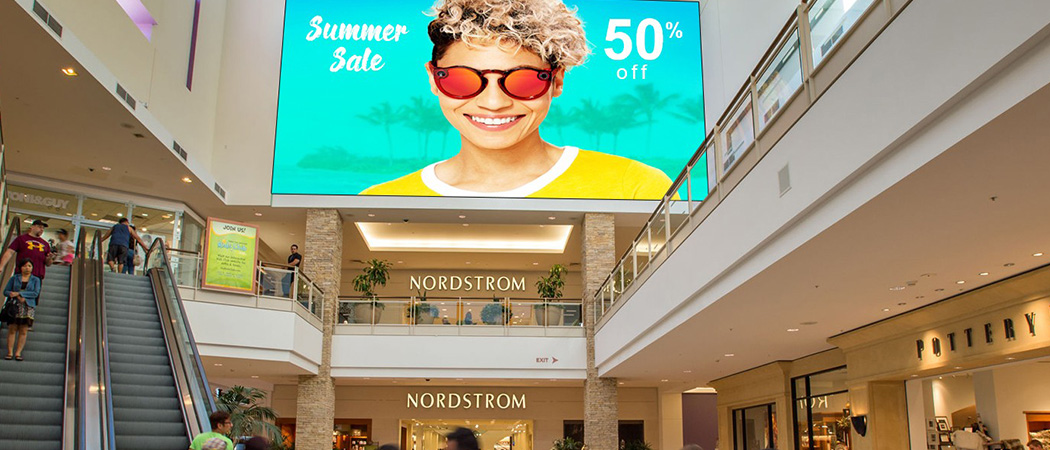
Active LED displays in the retail industry play a transformative role by enhancing customer engagement, improving the shopping experience, and driving sales. These displays offer a visually stunning way to showcase products, promotions, and dynamic content, while also providing opportunities for interactive and personalized experiences. Retailers leverage LED displays to create immersive environments that attract attention, communicate brand messaging, and influence purchasing decisions.
Key Applications of Active LED Displays in Retail
1. Storefront and Window Displays
Dynamic Window Advertising: LED displays in storefront windows capture the attention of passersby with eye-catching visuals, animations, and video content. These displays can be used to promote sales, new arrivals, and seasonal collections, providing a strong incentive for people to enter the store.
Interactive Window Displays: Some retailers incorporate touch-screen technology into window LED displays, allowing customers to browse product catalogs, explore promotions, or even place orders from outside the store, even after hours.
2. In-Store Promotional Displays
Product Highlights and Offers: LED displays inside the store can be strategically placed to showcase key products, promotions, or limited-time offers. Retailers can update the content in real-time, making it easy to highlight flash sales, new stock, or bundle deals.
Point-of-Sale Displays: LED screens at checkout counters provide an opportunity to upsell or cross-sell products. These displays can promote add-ons, membership programs, or rewards cards, encouraging last-minute purchases as customers check out.
3. Interactive Product Displays
Touch-Screen Product Exploration: Retailers can use LED displays equipped with touch-screen functionality to allow customers to explore product features, watch demo videos, or customize items (like color, size, or style) digitally. This is especially effective for products that are difficult to display physically, such as large appliances or luxury items.
Augmented Reality (AR) Integration: By integrating LED displays with AR technology, customers can visualize products in different settings or try out various configurations (e.g., furniture in their living room or clothing on their own body using virtual fitting rooms).
4. Brand Storytelling and Immersive Experiences
Brand Videos and Campaigns: LED displays provide a platform for retailers to communicate their brand story through high-definition videos, animations, and live content. These displays are perfect for creating immersive brand experiences that captivate customers and reinforce the retailer’s message.
Themed Displays and Ambience: Retailers can use LED displays to set the mood in different sections of the store by displaying themed visuals that align with the current collection or campaign (e.g., summer vibes, holiday season, etc.). The dynamic lighting and colors help enhance the store’s atmosphere.
5. Wayfinding and Interactive Maps
Digital Wayfinding: In large department stores, shopping malls, or outlet centers, LED displays can serve as digital wayfinding tools to help customers navigate the store and locate specific products or departments. Interactive maps allow users to search for particular items or promotions, leading to a more efficient shopping experience.
Customer Assistance: LED displays can be used to guide customers to customer service desks, restrooms, or other essential areas within the store.
6. Personalized Shopping Experience
Data-Driven Targeting: Modern retail environments can utilize data from customer behavior to personalize the content shown on LED displays. For example, retailers can display personalized ads or promotions based on a customer’s past purchases, demographics, or even current location within the store using sensors or loyalty apps.
Real-Time Offers: LED displays can change content based on real-time factors like stock levels, current foot traffic, or local weather conditions, offering relevant promotions or product suggestions. For example, if it starts raining outside, the display might promote umbrellas or raincoats in-store.
7. Interactive Kiosks and Self-Service
Self-Service Kiosks: Retailers can use LED displays as part of interactive self-service kiosks that allow customers to check stock availability, order items, or make payments. These kiosks streamline the shopping process, reduce wait times, and provide customers with more control over their experience.
Virtual Product Catalogs: In stores with limited floor space, LED displays serve as virtual catalogs where customers can browse the full range of products, including items not physically available in-store. Customers can place orders for home delivery or in-store pickup.
8. Customer Engagement and Social Media Integration
Live Social Media Feeds: Retailers can enhance customer engagement by displaying live social media feeds on LED screens, showcasing user-generated content, reviews, or influencer collaborations. This not only promotes interaction but also builds trust as customers see real-time feedback and testimonials from other buyers.
Interactive Campaigns: By integrating LED displays with mobile apps or social media platforms, retailers can launch interactive marketing campaigns where customers participate in contests, polls, or digital scavenger hunts, creating a fun, engaging experience.
9. Event and Pop-Up Store Displays
Pop-Up Store Activation: For temporary retail spaces or pop-up events, LED displays provide a flexible and powerful way to showcase branding, products, and promotions. The screens can be quickly installed and customized for short-term events, creating a dynamic retail environment that can be adjusted as needed.
Event Promotion and Live Streaming: During special in-store events, LED displays can live stream fashion shows, product launches, or influencer appearances, attracting crowds and building excitement. The screens can also be used to promote upcoming events or exclusive offers for attendees.
10. Sustainability and Energy Efficiency
Sustainable Content Solutions: LED displays offer energy-efficient advertising solutions, helping retailers reduce their environmental impact. With the ability to update content digitally, retailers can also minimize paper waste from traditional signage and posters.
Environmental Messaging: Retailers with eco-friendly initiatives can use LED displays to promote sustainability campaigns, share information about their green practices, or encourage customers to participate in recycling or conservation efforts.
Benefits of Active LED Displays in Retail
Increased Customer Engagement: LED displays, with their vibrant colors and dynamic content, capture attention more effectively than static signs. The ability to showcase moving images and real-time updates keeps customers engaged and informed, improving the overall shopping experience.
Enhanced Brand Visibility: LED displays provide a visually impactful platform for brand messaging. They allow retailers to communicate their values, promotions, and product offerings in a way that is consistent with their brand identity, creating a strong visual presence in-store and on the storefront.
Flexibility and Real-Time Content Updates: One of the major advantages of LED displays is their flexibility. Retailers can easily change content to reflect new promotions, seasonal campaigns, or store events, and they can do so in real-time without the need for physical reinstallation.
Increased Sales and Conversions: By highlighting promotions, limited-time offers, or product features directly in-store, LED displays help influence purchasing decisions. Customers are more likely to make impulse purchases when they see dynamic, targeted messaging at key points throughout the shopping journey.
Interactive and Personalized Experiences: LED displays with touch-screen functionality and data integration provide a more personalized shopping experience. By allowing customers to interact with product displays or access personalized offers, retailers create a deeper connection with shoppers and foster brand loyalty.
Improved Operational Efficiency: In-store LED displays reduce the need for printed signage, cutting down on time and resources spent on manual updates. Real-time content management also ensures that promotions and product information are always accurate and up-to-date.
Sustainability: LED displays are energy-efficient and eco-friendly, offering a greener alternative to traditional signage. This not only reduces the store’s carbon footprint but also aligns with the growing consumer demand for sustainability.
Future Trends in Retail LED Displays
AI and Data-Driven Personalization: Future LED displays in retail will leverage AI to provide even more personalized content based on real-time customer data. Displays will adapt dynamically to customer preferences, location, and purchasing history.
Integration with AR/VR: LED displays will increasingly integrate with AR and VR technologies, providing immersive, interactive shopping experiences. Virtual fitting rooms, product customizations, and immersive brand experiences will become more common.
Seamless Omni-Channel Integration: LED displays will play a key role in blending online and offline retail experiences. Retailers will use them to offer in-store versions of online content, connect with mobile apps, and provide a seamless transition between digital and physical shopping.
Conclusion
In retail, Active LED displays create engaging, flexible, and visually impactful experiences that resonate with modern shoppers. From storefront advertising to personalized in-store interactions, LED technology enhances brand communication, boosts sales, and fosters customer loyalty. As retailers continue to adopt innovative, data-driven strategies, LED displays will be central to the future of in-store retail marketing
Products
Agency
Get In Touch
- Rajkot Gujarat India.
- +91 9974 601 712
- info@sohamimpex.co.in
Follow Us
Soham Impex has successfully built a presence in the Active LED Display for Advertising and Branding Purposes. We stand out with the help of our comprehensive LED design and build, catered to clients Pan-India.
Follow Us
Get In Touch
- +91 9824201712
- info@sohamimpex.co.in
- 150ft. Ring Road, Rajkot Gujarat India.


